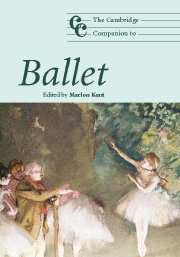
-
Select format
-
- Publisher:
- Cambridge University Press
- Publication date:
- September 2011
- June 2007
- ISBN:
- 9781139001625
- 9780521832212
- 9780521539869
- Dimensions:
- (247 x 174 mm)
- Weight & Pages:
- 0.83kg, 396 Pages
- Dimensions:
- (247 x 174 mm)
- Weight & Pages:
- 0.64kg, 396 Pages
- Subjects:
- Dance, Music, Music: General Interest, Music Performance
- Collection:
- The Cambridge Companions to Music
- Series:
- Cambridge Companions to Music
You may already have access via personal or institutional login- Subjects:
- Dance, Music, Music: General Interest, Music Performance
- Collection:
- The Cambridge Companions to Music
- Series:
- Cambridge Companions to Music
Book description
Ballet is a paradox: much loved but little studied. It is a beautiful fairy tale; detached from its origins and unrelated to the men and women who created it. Yet ballet has a history, little known and rarely presented. These great works have dark sides and moral ambiguities, not always nor immediately visible. The daring and challenging quality of ballet as well as its perceived 'safe' nature is not only one of its fascinations but one of the intriguing questions to be explored in this Companion. The essays reveal the conception, intent and underlying meaning of ballets and recreate the historical reality in which they emerged. The reader will find new and unexpected aspects of ballet, its history and its aesthetics, the evolution of plot and narrative, new insights into the reality of training, the choice of costume and the transformation of an old art in a modern world.
Reviews
' … a stimulating read if your curiosity has already been aroused as to how and why ballet is like it is, and whether it has a future as well as a past.'
Source: Dance Now
'This volume has a place in the libraries of dance institutions, but history departments may find it of use, as will anyone with a keen interest in classical and modern dance.'
Source: Reference Reviews
Contents
Metrics
Altmetric attention score
Full text views
Full text views help Loading metrics...
Loading metrics...
* Views captured on Cambridge Core between #date#. This data will be updated every 24 hours.
Usage data cannot currently be displayed.
Accessibility standard: Unknown
Why this information is here
This section outlines the accessibility features of this content - including support for screen readers, full keyboard navigation and high-contrast display options. This may not be relevant for you.
Accessibility Information
Accessibility compliance for the PDF of this book is currently unknown and may be updated in the future.


